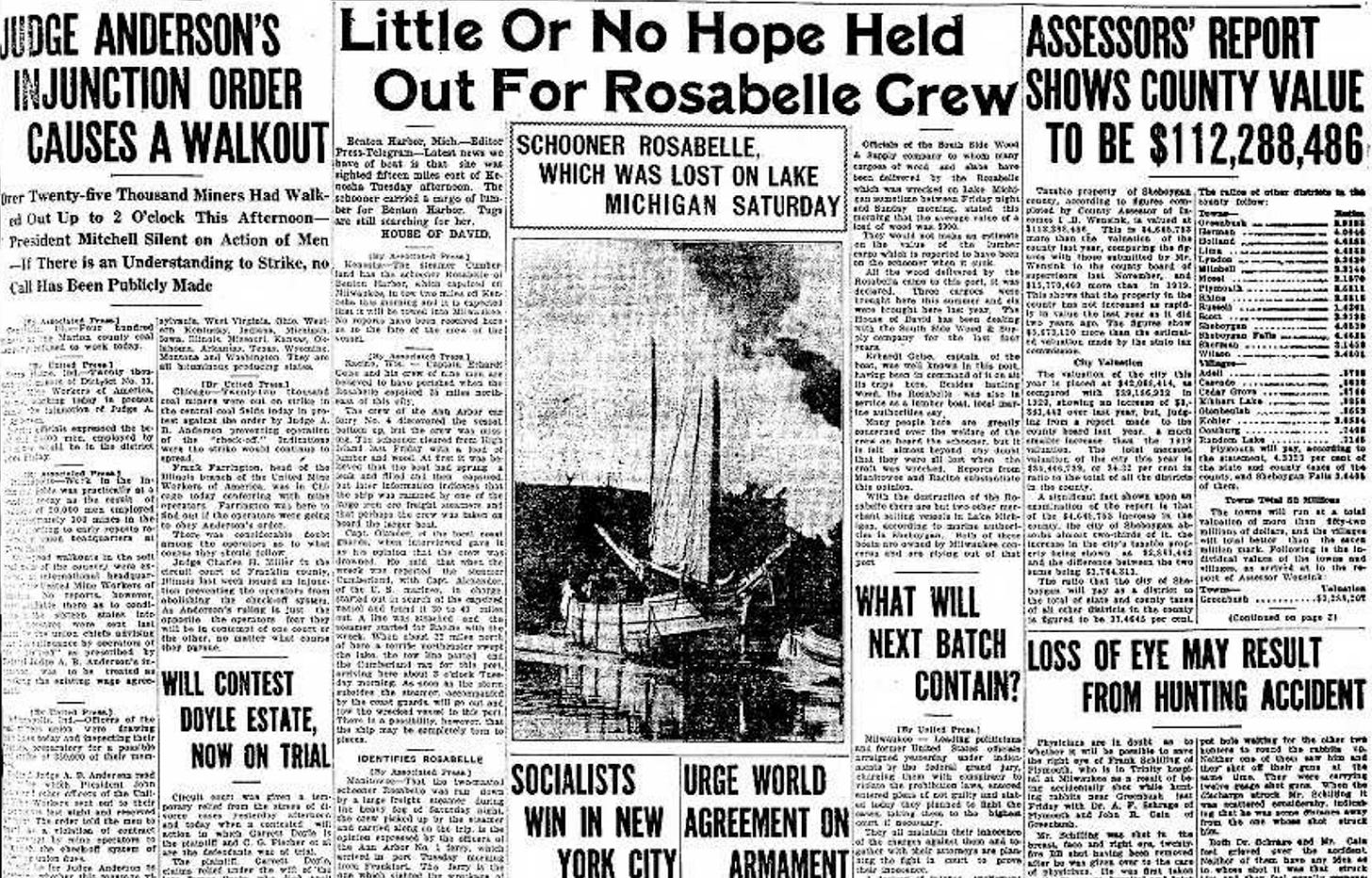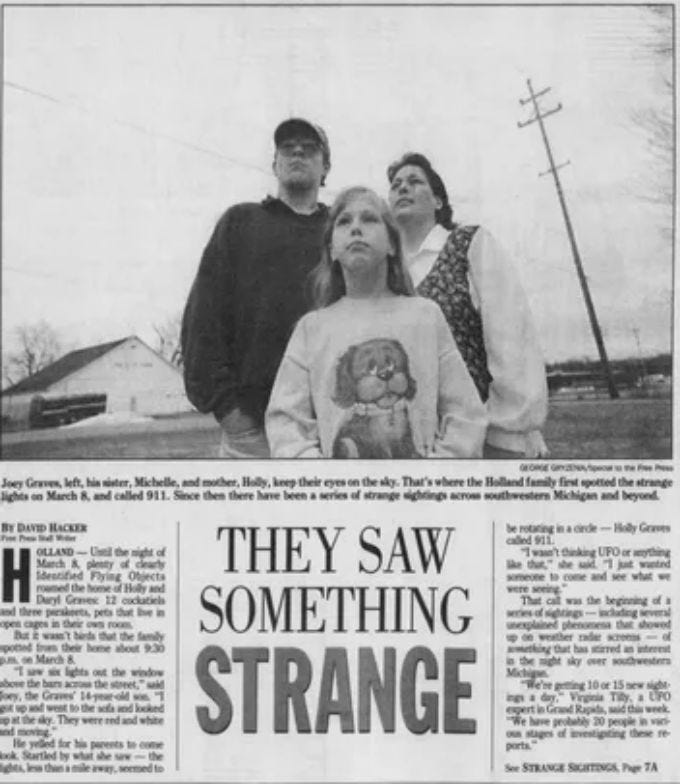The Misappearance of Steven Kubacki
Part 4: Fireball
If you’re new here, we suggest starting with Part 1.
The men in the House of David grew their hair and beards everlong, in order to look more like Jesus. Their leader, Benjamin Purnell, claimed he was the Seventh Messenger foretold in the Book of Revelations to herald the coming end of days. He and his wife Mary first tried to establish themselves in Ohio in the late 1800s, but were driven out after their teenage daughter died in an explosion at a fireworks factory and the couple refused to attend her funeral. Nonetheless, after Mary and Benjamin re-settled in Benton Harbor, Michigan, in 1903, the House of David easily recruited new members, including two wealthy businessmen who donated acres of land and the equivalent of millions of dollars.
A simple transaction afforded entry into the commune: Adherents would hand over all their worldly goods to Benjamin, in exchange for the promise of eternal life when Jesus returned to restore the Garden of Eden along Lake Michigan. According to Benjamin, this was imminent.
The members of the House of David didn’t drink, use tobacco, or have sex – even married couples. But apparently, they were loads of fun, and remarkably self-sufficient. With ample expendable energy, they built a hotel, a zoo, an amusement park with a train running through it; formed a jazz band, and ran a farmer’s market. Tourists found it all irresistible; no doubt Jesus would feel the same.
House of David’s most famous export was its baseball team, barnstormers who sold out stadiums throughout North America, in part because of their curious presentation and crowdpleasing hijinks: choreographed dances; disappearing acts with balls that would then magically emerge from their beards. But they were exceptionally good players, with an overall winning average of .750. Disqualified from the major league because of their facial hair, the House of David team was often invited to play major league teams in exhibition games, and sometimes, they won.

The House of David also operated a lumber outfit on remote High Island, at the very northern point of Lake Michigan. In late October 1921, a crew of 10 or 11 men set out for Benton Harbor, carrying a large shipment of lumber on the Rosabelle. But they never made it. On October 29, 1921, a ferry found the capsized boat some miles from the Wisconsin coast.
All signs pointed to a crash, and the damage suggested the Rosabelle was rammed by a freight steamer. Initially, the local Coast Guard unit hoped the crew had been carried off by the larger boat, as there was no sign of the men even though the wreck was likely discovered fairly soon after whatever disaster befell it.
But the crew was never found, and neither was any other vessel that might have been involved in a purported collision, which tore the stern out of the schooner. And this was the second unsolved mystery involving the Rosabelle: The ship wrecked in 1921 had been rebuilt and took its name from a vessel that met a similar fate in 1875, near Grand Haven: Capsized boat, looked like a crash, no cause was ever found, and all of the crew was lost.

Of course, none of this necessarily means that the House of David crew was raptured or carried off through an inter-dimensional portal. In 1921, a bootlegger would have cause to limp away from a crash without reporting it (though a rumrunner probably would have been no bigger than the Rosabelle, and unlikely to cause such extensive damage). Like some of the mysterious vanishings in and around Lake Michigan, there *could* be a practical explanation. It’s just that no one has ever found one. For this, and for the many more unexplained sightings, disasters, and disappearances; the most famous among them the Northwest Orient Flight 2501 tragedy of 1950, which killed 58 people and was at the time the deadliest commercial aircraft disaster in the country.
Traveling from New York’s LaGuardia airport to Seattle on June 23, the Douglas DC-4 made its last radio contact at 11:13 p.m. while flying over Lake Michigan. The next morning, search crews set out to find the aircraft near the location of its final radio transmission, and found no sign of the plane itself. Later the same day, the Coast Guard discovered an oil slick near Benton Harbor, where they recovered items that could have fallen freely from the plane: Luggage, cushions, blankets, pillows. Eventually, shredded body parts began to wash up on the shore of Lake Michigan. The state of the human remains suggested a mid-air explosion, but the items recovered showed no signs of fire damage. The aircraft has never been found, despite annual searches, and there’s never been any explanation for the disaster. But two police officers reported seeing a strange red light over Lake Michigan about two hours after the plane’s last radio communication. The light hovered in the sky for ten minutes before it abruptly disappeared.

Years later, on March 8, 1994, hundreds of Michigan residents reported seeing clusters of five or six unusual, cylindrically-shaped objects in the sky, some with colored lights. One observer likened the objects to a string of floating Christmas lights, another described a “fireball with red and green lights falling to Earth.”
A National Weather Service radar operator was among the witnesses.
"I've never seen anything like this, not even when I'm doing storms," the operator said in a 911 call with a police officer. "These aren't storms."
The officer on the line was from the police force in Holland, where many of the sightings were concentrated, and where Steven Kubacki was a student at Hope College when he disappeared in February 1978.
The sightings have never been explained.
There are so many of these stories that I can’t get into all of them here, but Cold Dead Hands highly recommends the Lake Michigan Triangle episode of the “Strange Sessions” podcast if you want to know more (you do!)
It’s in that episode that I first heard perhaps the strangest Lake Michigan story of all. This one never made the news. According to an account she published in a blog post, Kathy Doore was part of a competitive sailing crew that had gone for a practice run on Lake Michigan on a hot summer evening, three groups of them in wooden sailboats. In her own words:
Not an hour out of port and quite unexpectedly, a dense fog rapidly descended upon us … The winds were erratic, filling the mainsail from two opposing directions … I leaned over the rail and looked at the surface of the lake. It was calm with little movement. Strangely, a few seconds later as I righted myself, I found I was extremely cold.
I turned toward the helm to ask my crew mates if they too were cold and to my utter astonishment they were no longer standing next to me … Dumfounded, I called out and located them standing up on the aft deck, where it was several degrees warmer. They seemed perplexed, and urged me to join them. That’s when I noticed that no one was steering the boat.
The Captain raised his arms high over his head, gleefully wiggling his hands and fingers in the air, and stated he hadn’t been steering for the past ten minutes. Yet, not one minute before, I was certain he had been standing next to me at the helm.
Draped in dense fog, the vessel began a curious aquatic dance. Slowly, but deliberately, she turned on her axis completing three perfect 360-degree pirouettes, without ever crossing the wind. Then, just as suddenly as it had appeared, the fog vanished. To our utter astonishment, we saw the other two boats all within a few hundred yards of each other, rotating in exactly the same manner.
Kathy goes on to describe feeling the tangible presence of her dead father, and not being able to account for hours of time once the boats returned to port. Stranger still, she says that none of the other sailors would ever acknowledge what happened.
“To my utter astonishment no one would talk about it. Worse yet, they behaved as if nothing out of the ordinary had happened. The vortical winds alone would have given them fodder for years. It became evident that I was the only one in remembrance.”
This was in early summer 1978, a few months after Kubacki vanished from a cross-country skiing area along the lake, and nearly a year before he would appear again miles away in Massachusetts.
As we mentioned before, the story of Kubacki’s mysterious disappearance and re-appearance lives primarily in the paranormal corners of the internet. A Google search of Kubacki’s name will bring up a number of blog posts, message boards, and podcasts concerned with things like UFO sightings and alien abductions. To my knowledge, Kubacki has never reached out to any of these bloggers or podcasters to ask for any kind of correction or revision. But a reference to his case as an illustration of amnesia in an academic textbook published in the 1980s was removed from future editions, and not arbitrarily.
For a while, I believed that Kubacki had chosen to divorce himself from the experience altogether; perhaps it represented something troubling or traumatic, or maybe he simply didn’t want his life to be defined by something that happened to him when he was barely into his adulthood. But I now have reason to believe that Kubacki is invested in how his story is being told, even if he’s not telling it himself.
I hope to be able to talk more about that soon. Until next time…
“Strange Sessions” co-host Kurt Konecny donated his time and his excellent research notes to help make this chapter possible. Thank you Kurt!

